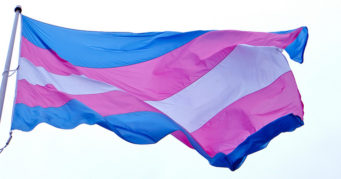How to Respond to Questions About Transgender Bathroom Access
April 27, 2016
Liberals: How Strong Is Your Support for Transgender Equality? by Nathaniel Frank
(this article first appeared on Slate.com and is reposted here with the author’s permission)
 In the wake of draconian laws passed in North Carolina and Mississippi restricting which restrooms transgender people can use, much of the attention has focused on the economic and political backlash to anti-LGBTQ discrimination. Sometimes, public pressure is the best or only tactic that works, and it’s heartening to see economic and political costs imposed on supporters of these odious laws. But it’s easy to forget just how important private conversations can be to securing lasting social change, especially in a campaign where winning hearts and minds is a key goal.
In the wake of draconian laws passed in North Carolina and Mississippi restricting which restrooms transgender people can use, much of the attention has focused on the economic and political backlash to anti-LGBTQ discrimination. Sometimes, public pressure is the best or only tactic that works, and it’s heartening to see economic and political costs imposed on supporters of these odious laws. But it’s easy to forget just how important private conversations can be to securing lasting social change, especially in a campaign where winning hearts and minds is a key goal.
Fortunately, media coverage of the laws has also spawned just such water cooler conversations, dialogues about what it means to be transgender and what full equality should look like.
To LGBTQ advocates, the question can seem rudimentary and even offensive. But it’s a reminder of just how unfamiliar most Americans are with transgender people and issues. And one of the key lessons we’ve learned from the success of the marriage equality movement is that mocking, punishing, and cajoling people to support equal rights is usually less effective than engaging in more positive ways with those who simply haven’t yet come to share your experience or viewpoint. Our country still has a ways to go simply to understand what it means to be transgender and to treat trans people equally. And that means these questions deserve answers. Here’s how I’d begin.
First of all, those of us pressing for policies of full respect for transgender identity should acknowledge that we’re asking others to make an adjustment. It’s no small matter for people who grew up accustomed to certain expectations about modesty and privacy in public facilities to alter those expectations overnight. Some people do, in fact, have visceral reactions to having their bodies seen by others, reactions that are so automatic that they can’t fairly be called political positions. It is not accurate or fair—and it’s certainly not productive—to call anyone who expresses discomfort about sharing a shower with someone who was born the opposite sex a bigot.
Second, those who question the fairness of asking cisgender people (the term for anyone who’s not transgender) to accept sharing bathrooms and locker rooms with trans people should ask themselves some hard questions, too: What, exactly, would bother you about the presence of trans people in your bathroom, and have you thought much about what it means to ask them to use what, for them, is entirely the wrong bathroom?
Some people are concerned on behalf of someone else. One family friend said that while she was too old to care who sees her body (or reveals their own), she worried that many young people are shy and could be made uncomfortable by shared facilities. What about their concerns?
The first thing to say about this is that the discomfort of others may be far less pronounced than you presume. There is relevant evidence from analogous situations in recent history. For years during the debate over “Don’t Ask, Don’t Tell,” senior military officials and older politicians and commentators insisted that young men from the heartland would be made untenably uncomfortable if they had to share intimate quarters with gay peers. Their privacy and trust would be compromised, went the argument, a situation that was both unfair and a threat to the military, since it could undermine group cohesion or even drive good troops away.
It turned out that the older generation was projecting. At least toward the end of the DADT debate, polls showed that young people were by and large totally comfortable with openly gay service, while older folks still had reservations. This may speak to the need to allow people time to get used to change. But then again, that’s what opponents of change always say, and there were reports even at the start of the DADT debate in the early 1990s indicating that it wasn’t more time that was needed but more leadership from the top. Young people are often more tolerant than older people, and they are quite resilient. As with countless other aspects of growing up, they get used to things they may not love—and grow stronger as a result.
The second thing to be said about the “privacy rationale” is that it doesn’t stand up to logic. Even conceding that some people have strong feelings about exposing their bodies to others, it’s not clear how gender segregation solves that problem. There’s no particular reason why people who dislike changing in front of others should feel better about it just because the others are the same sex. The goal of sex-segregated bathrooms was to keep the situation from becoming erotic or sexually charged (and, as was explained in Slate, to protect women from the presumed perils of public life when industrialization threw Victorian gender norms into disarray). But that thinking required the world to pretend that everyone was straight. In fact, it required erasing LGBTQ people from the universe. This is exactly what the military did by law when, recognizing the futility of rooting out gay people from the ranks, it required them to conceal their true identities, as though that would fool anyone into believing that no one would look at them with eyes of desire. Eventually, our nation tossed out this mutual fiction, and we are all better off for it.
There is another way the debate over transgender bathroom use echoes DADT. For all the handwringing over whether straight troops could share intimate quarters with gay people, the fact was they already were and always had been. It was a Wile E. Coyote moment writ large: You only fall from the cliff when you look down to see you’re already dangling in the air. Likewise, those worried about the discomfort or danger that sharing bathrooms with trans people could create should recognize that trans people have been using bathrooms that align with their gender identity for years. Indeed, it’s likely that many of us have already shared a public restroom with a trans person, and may not have known it, since some trans people “pass” as cisgender.
Then again, many cisgender people are gender-nonconforming, that is, exhibiting aspects of the gender that’s not their actual gender. This is a point worth dwelling on.
Whether trans or cis, it should not matter how “male” a man looks or how “female” a woman looks to let people enter the right bathroom. The fact that many trans people pass reminds us how absurd it is to force them into the bathroom corresponding to the gender assigned to them at birth; but passing is unevenly enjoyed, a privilege that should never become a litmus test to being able to pee in peace. Indeed, the fact that some trans people pass and some cis people get taken for the other gender shows how outdated it is to police gender norms in the first place.
This is particularly true in the modern age. Let’s remember, after all, what kinds of “exposure” to different bodies we’re really talking about here. Amid all the angst over shared bathrooms and locker rooms, you’d think that walking into a public restroom meant entering the inner ring of a Dionysian orgy. In reality, there are very few places in American life these days where anyone has to experience actual group nudity. Design norms for public bathing and changing facilities have been moving for decades toward greater individual privacy. This trend is reflected in single, rather than group, shower stalls in modern gyms, and in the military’s commitment this century to what’s called a “1+1” construction design for housing that offers most service members their own bedroom and a bathroom shared by just two people. The gang latrine is largely a relic.
Finally, in addition to presuming discomfort about changing with trans folks, some of the conversations I’ve witnessed have echoed concerns whipped up by religious conservatives that such a situation might actually cause violence. But on top of historical evidence from the DADT debate about the exaggeration of risk, there is also evidence from the present moment that transgender equality does not cause the doomsday scenarios conservatives claim it could. More than 200 cities and counties ban discrimination against transgender people, which generally means allowing them to use the bathroom that corresponds with their gender identity. Numerousinvestigations have shown that virtually no problems of abuse have followed from these laws. The smattering of instances that social conservatives claim show abuse, in fact, have nothing to do with the laws in question, as they occurred without the anti-transgender laws in place. Men can always dress up, enter a public bathroom, and inflict harm whether or not laws bar transgender people from using the appropriate bathroom. These laws are a solution in search of a problem.
While transgender equality does not cause harm, transgender discrimination does. Trans people, particularly transgender women of color, are at enormous risk for harassment, bullying, and violence. The rigid bathroom codes can only exacerbate that risk and the anxiety that goes along with it, forcing people into places where they don’t feel safe just for the sake of laws and policies that have little connection to reality.
The bottom line is that reluctance to respect the gender identity of transgender people, as with past failures to respect the sexuality of gays and lesbians, results from a lack of familiarity with, and empathy for, sexual minorities. If the LGBTQ equality movement has taught us anything, it is that good things happened when Americans awakened to the existence, plight, and full humanity of gay and transgender people. Equal treatment may be an adjustment for some. But the cost is ultimately small, and the pay-off is large for all of us. As one of my conversation partners told me, “It can take a long time to consider other people—and then be OK with differences.”

